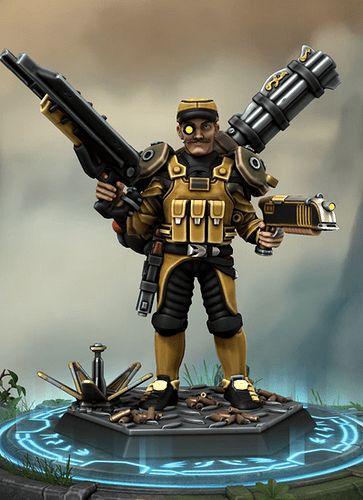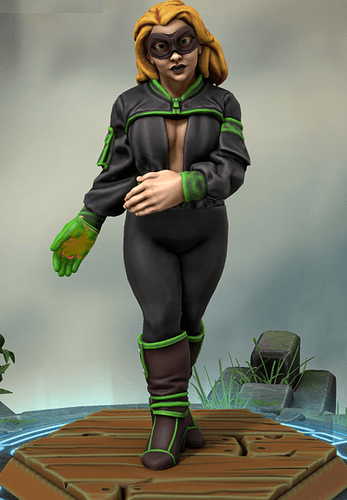Randomizers:
Approach: 9, 2, 3 [Options: Skilled, Prideful, Bully, Specialized, Generalist, Tactician]
Archetype: 1, 2, 4 [Options: Predator, Inventor, Bruiser, Guerilla, Indomitable, Overlord]
Upgrade: 12, 8, 3 [Options: Group Fighter, Quality Upgrade, Brainwashing Zone]
Mastery: 3, 7, 2 [Options: Conquest, Mysticism, Behind the Curtain]
Peacemonger

Real Name: Lyr Kalan, First Appearance: Earthwatch #112, July 1988
Approach: Prideful, Archetype: Indomitable
Upgrade: Group Fighter, Mastery: Conquest
Status Dice: Always d8. Health: 45+5H (Upgraded 65+5H)
Qualities: Conviction d10, Close Combat d10, Deep Space Lore d8, Alertness d8, Peacekeeper General d8
Powers: Strength d10, Presence d10, Awareness d10, Size-Changing d8
Abilities:
-
Strength in Victory [A]: Attack one target using Strength and use your Max+Min dice. If that Attack causes the target to change zones, Boost using your Mid die. That bonus is persistent and exclusive.
-
Stretch and Shrink [A]: Attack using Size-Changing. Either Hinder that target using Max, or Defend yourself using Min and you and that target end up elsewhere in the scene.
-
Order Bombardment [A]: Attack multiple targets using Conviction. Hinder those targets using your Min die.
-
Invulnerable (I): Reduce all damage dealt to you by 2.
Common Scene Elements:
-
Xur’Tani Battleships. These d10 lieutenants can act from a great distance, requiring special Overcomes to directly affect them.
-
Xur’Tani Peacekeepers. These d10 lieutenants are serum-empowered, and get +1 to Attacks and damage saves.
-
City Under Siege. A city under attack by alien ships, with peacekeepers on the streets.
As they approached the fiftieth anniversary of Venture Comics and Issue #600 of Celestial Travels, the only comic to have run uninterrupted since 1939, the writers of the series pitched an idea that would lead to dramatic changes in the setting and for its alien and super-science heroes. Although initially concerned that it was still too close to the Sovereign event, the editors of Venture ultimately agreed to the concept, and one of the most terrible villains in Venture Comics history was created - a villain utterly convinced of her own heroism. Peacemonger.
In the aftermath of the destruction of their homeworld, the Xur’Tani Republic was in chaos, with enemy nations growing in power and boldness by the day. General Lyr Kalan of the Xur’Tani Peackeepers believed that, in order to remain the galaxy’s defenders, the Xur’Tani would need to make sacrifices. They would need to be powerful. Most of all, they would need to be firm. In Earthwatch #112, General Kalan came to Earth, and approached Synthesis. She had learned of her formula, and asked Synthesis to give it to her for the good of the Xur’Tani people and the galaxy as a whole. Synthesis was swayed. She believed in her general’s vision, and the good of her people. She gave the formula to General Kalan.
Over the next six months, the Xur’Tani Peacekeepers began to take the serum. In the background of Celestial Travels and Earthwatch, references to Peacekeepers stopping attacks by Uranians, Jotari, and other alien forces grew, along with stories of increasingly stringent laws in Xur’Tani space designed to quash dissent and prevent anyone from getting out of line. Finally, at the end of Earthwatch #117, General Kalan, now calling herself Peacemonger, decided that there was only one threat to the return of Xur’Tani power. They had successfully developed the formula to manage Earth’s effect on them, but had not had luck in synthesizing the unique combination of atmosphere and bacteria that caused it. If Earth were conquering by an enemy force, or if the humans succeeded in destroying themselves, the power of the Peacekeepers would be broken. Peacemonger came to Synthesis, and explained that Earth’s population couldn’t be trusted to protect themselves. It was time for the Peacekeepers to occupy the Earth.
January through March of 1989 thus saw the “Peacekeepers” crossover, beginning with the Peacekeeper invasion of Earth to secure its atmospheric resources in Earthwatch #118, an invasion that was accomplished in a single day thanks to the efforts of thousands of skilled soldiers with the power of the Steward*.* The seven-part crossover covered Earthwatch, Champions of Truth, and Celestial Travels, with every other comic having one tie-in issue in either January or February about their own efforts to deal with Peacekeeper forces.
At first, Synthesis attempted to hold Earthwatch in line, insisting that the invasion of Earth was a necessary operation that would save millions of lives. Ember stood against her, seeing her own prior fanaticism in the team leader, and Earthwatch broke in half, with Hyperstar and Fission trusting Synthesis’s vision and Zeitgeist siding with the humans that he loved. Meanwhile, Reckoner attempted to end the invasion by calling out Peacemonger directly, resulting in a cosmically-powered duel between the two that she won, leaving him for dead.
When everything seemed lost, a shocking ally returned! The Drifter appeared to the Champions of Truth, leading the Steward himself. He explained that he had found the Steward drifting in the realms between worlds, and brought him back. He also explained that the Drifter held the power to end the invasion. His original, stronger infection could overwhelm Synthesis’ formula, dooming every Peacekeeper to death if they did not leave the Earth immediately.
The Steward announced his presence, his disappointment, and his plan in Champions of Truth #199, the fifth part of the crossover. Peacemonger responded immediately, gathering her forces and pointing everything she had at the man she claimed to respect, little realizing that her attack was leading her towards…
Behind the Scenes
… tomorrow’s villain!
That’s right, it’s an event so big that it needs two villains to write up!
The Xur’Tani plotline builds to a conclusion that’s probably not that surprising - Xur’Tani soldiers using the formula Synthesis developed to try to take over the Earth so that they can retain their galactic influence.
Peacemonger is just a devastating combatant, but once again she’s not that complicated of one. She hits hard, she can pin people down, and she has enough health and damage reduction to be hard to punk, but if you can wear her down you’ll probably be fine. The real threat is that she moves around with lieutenants, not minions.
 omg lol
omg lol




